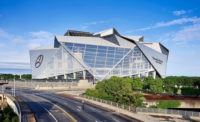Though it remains to be seen whether the Atlanta Falcons will meet expectations for the season, the National Football League team’s athletic facility has already earned the highest marks when it comes to being green. In mid-November 2017, the 2 million-square-foot Mercedes-Benz Stadium in Atlanta became the world’s first LEED Platinum–certified professional sports stadium.
Designed by HOK and home to the Falcons and the Atlanta United Major League Soccer (MLS) club, the stadium hosts 4,000 photo-voltaic (PV) panels, which should generate 1.6 million kilowatt hours per year—enough to power nine football games—and has enough electric vehicle connections to charge 48 cars at once. Among its many other green features, a 680,000-square-foot cistern can store 2 million gallons of rainwater, for both water-conservation and flood-control purposes. (The project sits at the top of the Proctor Creek watershed, just north of flood-prone downtown Atlanta.)
Worldwide, there are more than 30 LEED-certified sports venues, according to the U.S. Green Buildings Council (USGBC), but with 88 LEED points of a possible 110—the most of any athletic facility to date, and notably earning all possible credits for water—the Mercedes-Benz Stadium is the most impressive, and most recent, example of a growing trend. “Seven or eight years ago, we’d have to bring up the topic of sustainability with clients,” says architect Chris DeVolder, the sustainable design leader for HOK’s sports, recreation, and entertainment practice, who worked on the Atlanta stadium for almost four years. “Now we’re talking about it on every project.”
The Georgia venue completes a triumvirate of Platinum projects at different scales: in September 2016, the Sacramento King’s Golden 1 Center by AECOM became the first professional arena to earn Platinum, and five years before, in October 2011, the USGBC named Apogee Stadium by HKS, at the University of North Texas, the first Platinum collegiate football stadium in the nation.
“Now that we have three Platinum venues in the U.S., I think we’re ready to take it to the next level,” says Scott Jenkins, general manager of the Atlanta stadium and cofounder of the nonprofit Green Sports Alliance, established in 2010 to advise and connect athletic leagues, teams, and venues at all levels, with the goal of increasing sustainability. According to Jenkins, that could even mean taking on the ultra-stringent Living Building Challenge. “Owners are very competitive,” he says. “I think it’s just a matter of when, and where, and who wants to up the game.”
With 14 years of experience in this sector, HOK’s DeVolder has witnessed the growing interest in sustainable design firsthand, which he says started with a push to increase game-day recycling, then grew to encompass more efficient plumbing fixtures and heating, cooling, and energy systems. “In the last five years, these small steps have started to coalesce,” he says. “Now we’re looking beyond the four walls and starting to talk about the district scale.”
As if on cue, the Bjarke Ingels Group (BIG) released renderings in mid-December of a project with just those ambitions: the 1.3-million-square-foot East Austin District, proposed for a site northeast of the Texas capital’s downtown. The proposed complex, covered by a checkerboard canopy of red PV panels, is envisioned as a “collective campus rather than a monolithic stadium,” said firm founder Bjarke Ingels. It would contain a 40,000-seat outdoor stadium for soccer games and other large-scale events; a 15,000-seat multipurpose arena for Rodeo Austin; and additional space for retail, hospitality, and public plazas.
While the BIG concept is just one of several schemes aiming to bring a world-class venue—and an MLS team—to Austin, it falls in line with a broader theme. “The competitive nature of sports means that you innovate or someone beats you,” says Jenkins. “It’s just like any other business: you climb with the competition or watch people pass you by.”
Video courtesy EarthCam





Post a comment to this article
Report Abusive Comment